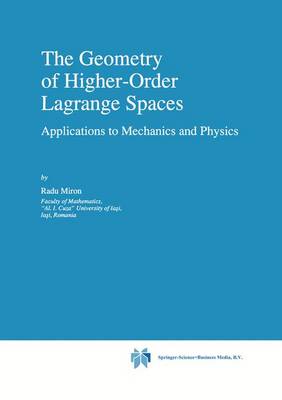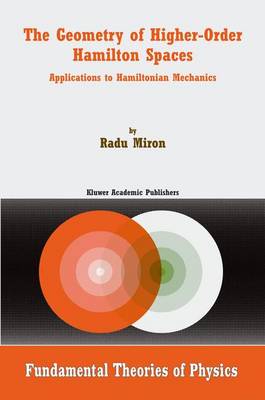Fundamental Theories of Physics
4 primary works
Book 59
The Geometry of Lagrange Spaces: Theory and Applications
by R. Miron and Mihai Anastasiei
Published 30 November 1993
Differential-geometric methods are gaining increasing importance in the understanding of a wide range of fundamental natural phenomena. Very often, the starting point for such studies is a variational problem formulated for a convenient Lagrangian. From a formal point of view, a Lagrangian is a smooth real function defined on the total space of the tangent bundle to a manifold satisfying some regularity conditions. The main purpose of this book is to present: (a) an extensive discussion of the geometry of the total space of a vector bundle; (b) a detailed exposition of Lagrange geometry; and (c) a description of the most important applications. New methods are described for construction geometrical models for applications.
The various chapters consider topics such as fibre and vector bundles, the Einstein equations, generalized Einstein--Yang--Mills equations, the geometry of the total space of a tangent bundle, Finsler and Lagrange spaces, relativistic geometrical optics, and the geometry of time-dependent Lagrangians. Prerequisites for using the book are a good foundation in general manifold theory and a general background in geometrical models in physics.
For mathematical physicists and applied mathematicians interested in the theory and applications of differential-geometric methods.
The various chapters consider topics such as fibre and vector bundles, the Einstein equations, generalized Einstein--Yang--Mills equations, the geometry of the total space of a tangent bundle, Finsler and Lagrange spaces, relativistic geometrical optics, and the geometry of time-dependent Lagrangians. Prerequisites for using the book are a good foundation in general manifold theory and a general background in geometrical models in physics.
For mathematical physicists and applied mathematicians interested in the theory and applications of differential-geometric methods.
Book 82
This monograph is mostly devoted to the problem of the geome- trizing of Lagrangians which depend on higher order accelerations. It naturally prolongs the theme of the monograph "The Geometry of La- grange spaces: Theory and Applications", written together with M. Anastasiei and published by Kluwer Academic Publishers in 1994. The existence of Lagrangians of order k > 1 has been contemplated by mechanicists and physicists for a long time. Einstein had grasped their presence in connection with the Brownian motion. They are also present in relativistic theories based on metrics which depend on speeds and accelerations of particles or in the Hamiltonian formulation of non- linear systems given by Korteweg-de Vries equations. There resulted from here the methods to be adopted in their theoretical treatment. One is based on the variational problem involving the integral action of the Lagrangian. A second one is derived from the axioms of Analytical Mechanics involving the Poincare-Cartan forms. The geometrical methods based on the study of the geometries of higher order could invigorate the whole theory.
This is the way adopted by us in defining and studying the Lagrange spaces of higher order. The problems raised by the geometrization of Lagrangians of order k > 1 investigated by many scholars: Ch. Ehresmann, P. Libermann, J. Pommaret; J.T. Synge, M. Crampin, P. Saunders; G.S. Asanov, P.Aringazin; I. Kolar, D. Krupka; M. de Leon, W. Sarlet, P. Cantrjin, H. Rund, W.M. Tulczyjew, A. Kawaguchi, K. Yano, K. Kondo, D.
This is the way adopted by us in defining and studying the Lagrange spaces of higher order. The problems raised by the geometrization of Lagrangians of order k > 1 investigated by many scholars: Ch. Ehresmann, P. Libermann, J. Pommaret; J.T. Synge, M. Crampin, P. Saunders; G.S. Asanov, P.Aringazin; I. Kolar, D. Krupka; M. de Leon, W. Sarlet, P. Cantrjin, H. Rund, W.M. Tulczyjew, A. Kawaguchi, K. Yano, K. Kondo, D.
Book 118
The Geometry of Hamilton and Lagrange Spaces
by R. Miron, Dragos Hrimiuc, Hideo Shimada, and Sorin V Sabau
Published 1 January 2001
The title of this book is no surprise for people working in the field of Analytical Mechanics. However, the geometric concepts of Lagrange space and Hamilton space are completely new. The geometry of Lagrange spaces, introduced and studied in [76],[96], was ext- sively examined in the last two decades by geometers and physicists from Canada, Germany, Hungary, Italy, Japan, Romania, Russia and U.S.A. Many international conferences were devoted to debate this subject, proceedings and monographs were published [10], [18], [112], [113],... A large area of applicability of this geometry is suggested by the connections to Biology, Mechanics, and Physics and also by its general setting as a generalization of Finsler and Riemannian geometries. The concept of Hamilton space, introduced in [105], [101] was intensively studied in [63], [66], [97],... and it has been successful, as a geometric theory of the Ham- tonian function the fundamental entity in Mechanics and Physics. The classical Legendre's duality makes possible a natural connection between Lagrange and - miltonspaces. It reveals new concepts and geometrical objects of Hamilton spaces that are dual to those which are similar in Lagrange spaces. Following this duality Cartan spaces introduced and studied in [98], [99],..., are, roughly speaking, the Legendre duals of certain Finsler spaces [98], [66], [67]. The above arguments make this monograph a continuation of [106], [113], emphasizing the Hamilton geometry.
Book 132
Asisknown,theLagrangeandHamiltongeometrieshaveappearedrelatively recently [76, 86]. Since 1980thesegeometrieshave beenintensivelystudied bymathematiciansandphysicistsfromRomania,Canada,Germany,Japan, Russia, Hungary,e.S.A. etc. PrestigiousscientificmeetingsdevotedtoLagrangeandHamiltongeome- tries and their applications have been organized in the above mentioned countries and a number ofbooks and monographs have been published by specialists in the field: R. Miron [94, 95], R. Mironand M. Anastasiei [99, 100], R. Miron, D. Hrimiuc, H. Shimadaand S.Sabau [115], P.L. Antonelli, R. Ingardenand M.Matsumoto [7]. Finslerspaces,whichformasubclassof theclassofLagrangespaces, havebeenthesubjectofsomeexcellentbooks, forexampleby:Yl.Matsumoto[76], M.AbateandG.Patrizio[1],D.Bao,S.S. Chernand Z.Shen [17]andA.BejancuandH.R.Farran [20]. Also, wewould liketopointoutthemonographsofM. Crampin [34], O.Krupkova [72] and D.Opri~,I.Butulescu [125],D.Saunders [144],whichcontainpertinentappli- cationsinanalyticalmechanicsandinthetheoryofpartialdifferentialequa- tions. Applicationsinmechanics, cosmology,theoreticalphysicsandbiology can be found in the well known books ofP.L. Antonelliand T.Zawstaniak [11], G.
S. Asanov [14]' S. Ikeda [59], :VI. de LeoneandP.Rodrigues [73]. TheimportanceofLagrangeandHamiltongeometriesconsistsofthefact that variational problems for important Lagrangiansor Hamiltonians have numerous applicationsinvariousfields, such asmathematics, thetheoryof dynamicalsystems, optimalcontrol, biology,andeconomy. Inthisrespect, P.L. Antonelli'sremark isinteresting: "ThereisnowstrongevidencethatthesymplecticgeometryofHamilto- niandynamicalsystemsisdeeplyconnectedtoCartangeometry,thedualof Finslergeometry", (seeV.I.Arnold,I.M.GelfandandV.S.Retach [13]). The above mentioned applications have also imposed the introduction x RaduMiron ofthe notionsofhigherorder Lagrangespacesand, ofcourse, higherorder Hamilton spaces. The base manifolds ofthese spaces are bundles ofaccel- erations ofsuperior order. The methods used in the construction ofthese geometries are the natural extensions ofthe classical methods used in the edification ofLagrange and Hamilton geometries.
These methods allow us to solvean old problemofdifferentialgeometryformulated by Bianchiand Bompiani [94]morethan 100yearsago,namelytheproblemofprolongation ofaRiemannianstructure gdefinedonthebasemanifoldM,tothetangent k bundleT M, k> 1. Bymeansofthissolutionofthe previousproblem, we canconstruct, for thefirst time,goodexamplesofregularLagrangiansand Hamiltoniansofhigherorder.
S. Asanov [14]' S. Ikeda [59], :VI. de LeoneandP.Rodrigues [73]. TheimportanceofLagrangeandHamiltongeometriesconsistsofthefact that variational problems for important Lagrangiansor Hamiltonians have numerous applicationsinvariousfields, such asmathematics, thetheoryof dynamicalsystems, optimalcontrol, biology,andeconomy. Inthisrespect, P.L. Antonelli'sremark isinteresting: "ThereisnowstrongevidencethatthesymplecticgeometryofHamilto- niandynamicalsystemsisdeeplyconnectedtoCartangeometry,thedualof Finslergeometry", (seeV.I.Arnold,I.M.GelfandandV.S.Retach [13]). The above mentioned applications have also imposed the introduction x RaduMiron ofthe notionsofhigherorder Lagrangespacesand, ofcourse, higherorder Hamilton spaces. The base manifolds ofthese spaces are bundles ofaccel- erations ofsuperior order. The methods used in the construction ofthese geometries are the natural extensions ofthe classical methods used in the edification ofLagrange and Hamilton geometries.
These methods allow us to solvean old problemofdifferentialgeometryformulated by Bianchiand Bompiani [94]morethan 100yearsago,namelytheproblemofprolongation ofaRiemannianstructure gdefinedonthebasemanifoldM,tothetangent k bundleT M, k> 1. Bymeansofthissolutionofthe previousproblem, we canconstruct, for thefirst time,goodexamplesofregularLagrangiansand Hamiltoniansofhigherorder.



